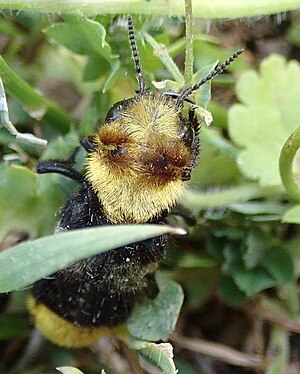Hairy short-winged species
| Hairy short-winged species | ||||||||||||
|---|---|---|---|---|---|---|---|---|---|---|---|---|

Emus hirtus |
||||||||||||
| Systematics | ||||||||||||
|
||||||||||||
| Scientific name | ||||||||||||
| Emus hirtus | ||||||||||||
| ( Linnaeus , 1758) |
The Hairy Rift-winged Beetle ( Emus hirtus ) is one of the largest and most conspicuous beetles from the family of the Kurzwügler (Staphylinidae) in Europe.
features
The 18 to 28 millimeter long animals have a conspicuously protruding, golden-yellow hair on the head, most of the pronotum and the 4th to 6th tergite . The back half of the elytra is gray, the rest of the body is hairy black. The body has a faint, dark purple metallic sheen. The antennae are very short, the last six transverse segments form a slightly separated lobe.
Occurrence
The species occurs all over Europe, from the extreme southwest, across Central Europe to the Mediterranean and the Balkans ; outside of Europe also in front and western central Asia . It is absent in the far north and on the Mediterranean islands.
In Germany it has been found in all federal states except Saarland, but has often been lost for decades. It shows a strong fluctuation, especially at the northern border of its distribution area, so that in many places it occurs only occasionally and then disappears again for several years or decades.
Way of life
The preferred habitat are near-natural pastures; But also habitats in the vicinity of settlements, river valleys, moist meadows through to dry grassland and dunes are settled.
Emus hirtus lives as a larva and as an imago mainly on and in fresh animal excrement, preferably in those of cattle or horses. The species has also been observed on mushrooms and carrion. It mainly hunts adults and larval stages of flies and other beetles. The water-repellent hair protects them when living in damp manure from sticking together limbs and sensory bristles. Their coloring is possibly a form of Bates' mimicry , so that they look like a defensive wasp or bumblebee. In case of danger, the mandibles are also spread and the abdomen is stretched upwards. The Imago is fully airworthy and can be found from the end of April to August.
Danger
Emus hirtus is a rare species in Germany that is also endangered by the use of biocides, intensification of agriculture and changes in use on dry and wet locations. In the Red List for Germany the species is listed in Category 2 (endangered). For Mecklenburg-Western Pomerania, category 1 (threatened with extinction) is proposed, in Bavaria it is classified as “endangered” (category 3).
Individual evidence
- ↑ Margret Binot and a .: Germany's Red List of Endangered Animals. Federal Agency for Nature Conservation. 1998.
- ↑ Heinz Bußler, Günter Hofmann: Red list of endangered Kurzflüglerartiger (Coleoptera: Staphylinoidea) Bavaria. Bavarian State Office for the Environment. 2003.
literature
- Andreas Kleeberg, Manfred Uhlig: The Staphylinina (Insecta, Coleoptera, Staphylinidae) in Mecklenburg-Western Pomerania, 1847-2009: History of research, annotated list of species, distribution and draft of a red list. In: Insecta. Journal of Entomology and Conservation. Naturschutzbund Deutschland eV 2011, No. 13, pp. 5-137.
- Heinz Joy , Karl Wilhelm Harde , Gustav A. Lohse : The beetles of Central Europe. Volume 4: Staphylinidae I (Micropeplinae to Tachyporinae). Goecke & Evers Verlag, Krefeld 1969.
Web links
- Emus hirtus at Fauna Europaea
